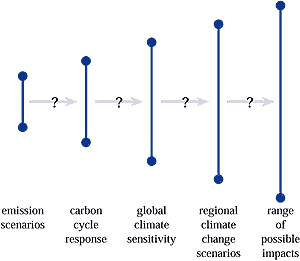2.6.4. Aggregation and the Cascade of Uncertainty

Figure 2-2: Range of major uncertainties that are typical in impact
assessments, showing the "uncertainty explosion" as these ranges
are multiplied to encompass a comprehensive range of future consequences,
including physical, economic, social, and political impacts and policy responses
(modified after Jones, 2000, and "cascading pyramid of uncertainties"
in Schneider, 1983) |
A single aggregated damage function or a "best guess"
climate sensitivity estimate is a very restricted representation of the wide range
of beliefs available in the literature or among lead authors about climate sensitivity
or climate damages. If a causal chain includes several different processes, the
aggregate distribution might have very different characteristics than the various
distributions that constitute the links of the chain of causality (see Jones,
2000). Thus, poorly managed projected ranges in impact assessment may inadvertently
propagate uncertainty. The process whereby uncertainty accumulates throughout
the process of climate change prediction and impact assessment has been described
as a "cascade of uncertainty" (Schneider, 1983) or the "uncertainty
explosion" (Henderson-Sellers, 1993). The cascade of uncertainty implied
by coupling the separate probability distributions for emissions and biogeochemical
cycle calculations to arrive at concentrations needed to calculate radiative forcing,
climate sensitivity, climate impacts, and valuation of such impacts into climate
damage functions has yet to be produced in the literature (see Schneider, 1997,
Table 2). When the upper and lower limits of projected ranges of uncertainty are
applied to impact models, the range of possible impacts commonly becomes too large
for practical application of adaptation options (Pittock and Jones, 1999). This
technique is less explicitly applied in assessments where two or more scenarios
(e.g., M1 to M4 in Figure 2-1) are used and the results
expressed as a range of outcomes. If an assessment is continued through to economic
and social outcomes, even larger ranges of uncertainty can be accumulated (see
Figure 2-2).
Because of the lack of consistent guidance on the treatment of uncertainties,
diversity of subject areas, methods, and stage of development of the many fields
of research to be assessed in the SAR, it was not possible to agree on a single
set of terms to describe the confidence that should be associated with the many
outcomes and/or processes that had been assessed. Thus, the uncertainties guidance
paper (see also Box 1-1) suggests that the TAR authors
agree on two alternative sets of terms from which writing teams can select (see
Figures 2 and 3 in Moss and Schneider, 2000). As noted in the decision analysis
literature (e.g., Morgan and Henrion, 1990), it is important to attach a
quantitative range to each verbal characterization to assure that different
users of the same language mean the same degree of confidence.
|